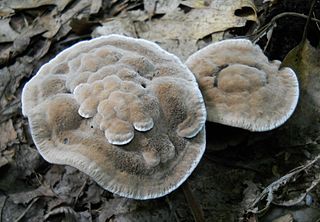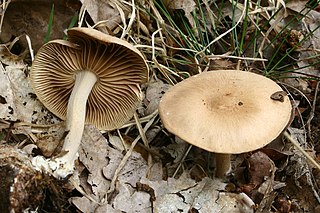
Psilocybe silvatica is a psilocybin mushroom in the section Semilanceatae of the genus Psilocybe. Psilocybin is the main active compound.

Collybiopsis is a resurrected genus in the Omphalotaceae family of mushrooms. Collybiopsis was originally proposed in 1909 and resurrected in 2021.

Sillia is a genus of fungi within the Sydowiellaceae family.

Underwoodia is a genus of ascomycete fungi in the order Pezizales. The widespread genus contained many species, beforre they were transferred to the Geomorium genus. The genus, described by Charles Horton Peck in 1890, honors mycologist Lucien Marcus Underwood.

Morchella angusticeps is a species of fungus in the family Morchellaceae native to eastern North America. Described by Charles Horton Peck in 1879, the name M. angusticeps was clarified in 2012 prior to which this species may have been referred to as either M. angusticeps or M. elata. M. angusticeps is one of the black morels, and is found in eastern North America, where it occurs in association with various hardwoods in the spring.

Puccinia mariae-wilsoniae, commonly known as the spring beauty rust, is a species of rust fungus found in North America. A plant pathogen, it grows on the leaves of the spring beauty flowering plants Claytonia caroliniana and C. virginica.

Russula rugulosa is a species of agaric fungus in the family Russulaceae. It was first described by American mycologist Charles Horton Peck in 1902.

Mary Elizabeth Banning (1822–1903) was an American mycologist and botanical illustrator from Maryland.

Hydnum umbilicatum, commonly known as the depressed hedgehog, is a species of tooth fungus in the family Hydnaceae. It was scientifically described in 1902 from New York by American mycologist Charles Horton Peck. It is found in eastern North America. It is edible and good.
Tylopilus nebulosus is a species of bolete fungus in the family Boletaceae found in eastern North America. It was originally described by Charles Horton Peck in 1898 as a species of Boletus, from collections made in Ray Brook, New York. Carl B. Wolfe transferred it to the genus Tylopilus in 1980.

Hydnellum spongiosipes, commonly known as the velvet tooth, is a tooth fungus in the family Bankeraceae. It is found in Europe and North America. In Switzerland, it is considered a vulnerable species.

Suillus punctipes, commonly known as the spicy suillus, is a bolete fungus in the family Suillaceae.
Hydnellum conigenum, commonly known as the funnel hydnum, is a species of tooth fungus in the family Bankeraceae found in North America. It was first described in 1903 by American mycologist Charles Horton Peck from collections made growing on fallen cones of ponderosa pine, near the base of the Moscow Mountains. Peck thought it was similar to H. aurantiacum, differing in its smaller size, more slender stipe, non-zoned flesh, more even cap, and somewhat unusual substrate. Howard James Banker transferred it to the genus Hydnellum in 1906. Its range extends from New Mexico to British Columbia and the Great Lakes region, where it grows in coniferous forests.

Leucoagaricus rubrotinctus, commonly known as the red-eyed parasol, is a widespread species of fungus in the family Agaricaceae. It was described as new to science in 1884 by American mycologist Charles Horton Peck as Agaricus rubrotinctus. Rolf Singer transferred it to the genus Leucoagaricus in 1948. The fungus may be a complex of several closely related species. It is inedible.

Mycena subcaerulea is a species of mushroom-forming fungus in the family Mycenaceae. It produces small, thin-fleshed fruitbodies with pale bluish-green caps upon slender stipes. The centers of the caps are darker in colour than the margins, and the cap cuticle can be peeled off. The fungus was first described in 1873 as Agaricus subcaeruleus by American mycologist Charles Horton Peck. His original collections, found growing on the trunks of decaying beech trees, were made in woods of the Adirondack Mountains in Upstate New York. Pier Andrea Saccardo transferred the species to the genus Mycena in 1887.

Aureoboletus auriporus, is a species of bolete fungus in the family Boletaceae that is found in Europe and North America. It was originally described in 1872 by American mycologist Charles Horton Peck, who called it Boletus auriporus. Zdenek Pouzar transferred it to the genus Aureoboletus in 1957.

Bovista colorata is a species of puffball fungus in the family Agaricaceae. It is found in eastern North America and northwestern South America. The puffball was first described as Lycoperdon coloratum by Charles Horton Peck in 1878, from collections made in Sand Lake, New York. Hanns Kreisel transferred it to the genus Bovista by in 1964. The golden to orange-yellow fruitbodies are 13–30 cm (5.1–11.8 in) in diameter. Its spores are spherical, measuring 3.5–5 μm in diameter.
Sarcodon scabripes is a species of fungus in the family Bankeraceae found in Asia, Europe, and North America. It was originally described in 1897 as Hydnum scabripes by Charles Horton Peck. Howard James Banker transferred it to the genus Sarcodon in 1906. The fungus makes fruit bodies with a drab gray to flesh-colored cap, and flesh that is white. In addition to the United States, where it was first documented, S. scabripes has been reported from Japan and the Sverdlovsk Oblast region of Russia.

Collybiopsis peronata, also known as wood woolly-foot, is a species of gilled mushroom which is common in European woods.
Auriporia aurea is a species of poroid fungus. It was first described scientifically by Charles Horton Peck in 1890 as Poria aurea. Leif Ryvarden transferred it to the new genus Auriporia, in which it is the type species.
















